3.1 Organising activities
By Sarah Laustroer
What kinds of measures
should be implemented
together?
The term “measures” comes from the language used in project funding applications. It refers to the activities that are required to achieve a predefined objective. Such measures should be thought of as a larger unit in which several activities can be combined. For example, the measure “exchange visit” may include a preparatory visit or a follow-up meeting, as well as other preparatory activities (e.g. a video conference) and the activities that take place during the visit itself.
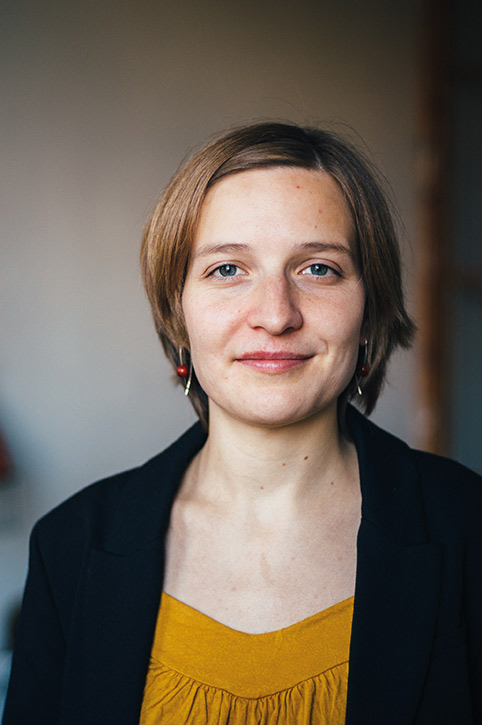
International education partnerships and projects thrive as a result of the specific activities that they pursue. Joint activities and experiences intensify the contact among the partners and strengthen the connection between them. This enables both sides to present themselves and to share their views, which allows for a more enriching experience. When choosing the type of activity, there are virtually no limits to the imagination.
Sarah Laustroer
Educational Assistant and Project Coordinator, Association of Lower Saxony Education Initiatives (VNB), Germany
Measures are the centrepiece of any education partnership or project and bring it to life. Different types of measures are possible, and education partnerships and projects vary greatly in their structure and activities. A look at the examples of education partnerships and projects contained in this handbook alone reveals the wide range of possible options. To make these options more manageable, we have divided the most common types of measures into the following broad categories:
- Exchanges via different media, i.e. letters, video messages, live chats or similar methods;
- Exchange visits, where one partner group visits the other in their country;
- Developing a joint product, such as a book, a piece of music, a film or a play, or implementing a project together;
- Political actions.
This chapter does not include fundraising activities such as charity runs as a category of their own. They can act as an additional means of raising money for the implementation of other activities (see Chapter 3.5 for more information). Taken alone, however, they do not really constitute a measure in the sense of an education partnership. An education partnership is about learning together and engaging and working with each other on an equal footing, in order to enable open-ended learning on both sides. If a partnership is about collecting money in one country in order to provide financial support for the partners in the other country, it is more appropriate to speak of “sponsorship” rather than “partnership”. In this case, a clear hierarchy of givers and takers will be established. Charitable partnerships or sponsorships are therefore not considered in this handbook.
The categories mentioned above offer only a first indication of the possibilities and should therefore be seen as complementary rather than rigid. For more inspiration on how to shape your own partnership, it is worth consulting the project ideas contained in this handbook, to have a look at what others are doing and to use your own imagination.
In the past, students used to be pen pals, but today, thanks to digital media, the possibilities for exchanging information over great distances have proliferated. The basic idea, however, is still the same. An actual encounter is not always necessary and feasible, for example because the participants are too young, or the organisation of a trip would be too complex and expensive. Nevertheless, there are other options for arranging face-to-face exchanges even in the face of physical distance. The options range from low-threshold to ambitious, and from a one-time interaction to a long-term exchange.
Students can still engage with each other as pen pals, but they will probably do so by email rather than by post. Email offers the advantage of reaching the recipient much more quickly than a traditional letter. Such exchanges can also be supplemented by sharing photos and video messages or by interactive presentations or guided tours, for example through an Augmented Reality tour1 of the school garden, if the relevant technical knowledge is available. This involves superimposing texts, graphics and videos over a photo, thereby allowing users to explore the various elements and to get a better idea of the image. All these are examples of long-term exchanges that can take place without any thematic focus. Often, however, setting a topic can simplify the communication.
There is also the possibility of organising a direct exchange in the form of a live chat. In this case, the participants meet online at a specified time using a video conferencing platform, for example via Skype, Zoom, Jitsi or BigBlueButton. The discussion should be carefully prepared and moderated so that no long and uncomfortable pauses occur in which nobody knows what to say or ask and to prevent people from talking over each other, which makes it difficult for the other side to follow what is going on. Live chats can either take the form of an exchange between two groups or of an interview where one group interviews one person from another country. They can be organised as part of a longer-term exchange or simply as a one-off experience. In any case, organisers need to take into account the time differences between the two countries..
Another option are online seminars, in which small groups take turns to organise sessions for all participants.
1) Augmented Reality: The term “augmented reality” refers to an expansion of visual perception.
The “Chat der Welten (“Chat of Worlds”) programme organises live chats between schools or groups in Germany and people from other countries. www.t1p.de/chat-der-welten
(website in German)
As the coordinator of the Learn2Change network, VNB can help you in finding partners for international dialogue and the organisation of live chats. www.t1p.de/L2C-Skype-Interviews- English
Exchange visits are a popular and widely used measure, especially in the case of long-term partnerships. They provide a great opportunity to see how the partners live, to get to know each other personally and to strengthen the relationship through shared experiences. It is ideal if such encounters are organised as exchange trips in both directions, so that both sides have the opportunity to visit their partners; otherwise, there is a risk that the relationship will be imbalanced, and that one side will dominate in terms of knowledge or experience.
Exchange visits require sound organisational and educational support, both during the trip itself and during the preparation and follow-up work. Ideally, the preparation should consist of a mixture of organisational information, preparatory work on the topic of the trip/ exchange (where applicable), efforts to empower the group and the participants, and intercultural or Global Learning activities. If participants are travelling to a country outside their own continent for the first time, such trips are often accompanied by many questions and uncertainties – both on their part and that of their parents/legal guardians. Consequently, the organises should provide detailed information about the trip, the necessary documents, safety instructions, the programme, and food and accommodation. It is equally important to prepare the participants for new and unforeseen experiences. Such trips often don‘t go exactly according to plan and participants are frequently confronted with new experiences in the partner country. Openness and trust (in oneself, the chaperones and the group) can help the participants to cope with these experiences. In addition, stereotypes and prejudices should be identified before the trip in order to open the participants‘ eyes to new things and experiences. Otherwise, the participants may selectively interpret their impressions in such a way that existing stereotypes become reinforced and consolidated.
During the exchange visit, the participants should know who to turn to in case of questions or issues. It is also a good idea to leave some space for reflection. It may be beneficial for the participants to meet once a day in their “country group” to exchange views in their mother tongue about how they are doing and what they find unsettling, annoying, surprising or gratifying. This continuous interaction and reflection on what they have experienced makes it easier for the participants to deal with new and unfamiliar experiences and prevents them from shutting themselves off or rebelling due to excessive demands and uncertainty.
Sometime after the exchange visit, a follow-up should take place. In addition to reviewing or summarising the results, the participants should also have the opportunity to reflect on what they have experienced, share their personal thoughts and review their earlier stereotypes. If it goes hand in hand with proper preparation and follow-up work, an exchange visit offers great opportunities for intercultural learning.
Taking part in such an exchange trip is often an attractive prospect, but there are usually only a limited number of places available. If more teenagers/young adults want to take part than there are places available, a selection must be made, which is often not so easy. What is important is that the selection is transparent, focused on diversity and as fair as possible, using specified, justifiable criteria.
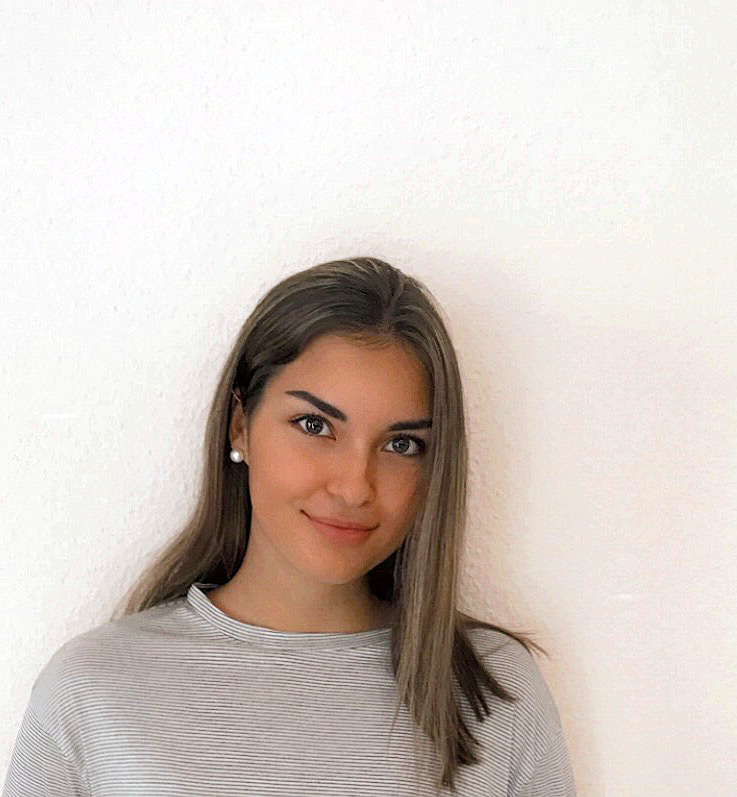
Travelling to a foreign country and meeting new people is a unique and often overwhelming experience – one that everyone should have the chance to experience at least once. While it is easy to get excited about the culture and environment, what makes this experience truly special are the local people. I‘ve learned a lot on this journey. On the one hand that we as human beings are all basically the same, and on the other hand that we can achieve incredible things if we stick together. We need to keep working to improve ourselves and the world and see to it that there are more and more encounters and exchanges between people and countries. After many such experiences, my view of the world has changed completely. Now I‘m convinced that a world without racism and wars is possible.
Marie Finiefs
Student of the Tilman-Riemenschneider- Gymnasium in Osterode am Harz, Germany
My family wanted me to follow the same trend as my sisters and marry at an early age and someone of their choice to reduce their responsibilities. For weeks, I was in a dilemma, torn between listening to their opinions about my own life and making a bold decision to focus on achieving my dreams – until I had the opportunity to participate in the school exchange programme. When I returned, I realised that I‘d grown a lot, especially thanks to my host sister, and that my learning ability has been enhanced as well.
The programme gave me exposure, built up my confidence and enabled me to stand up for my rights in front of my family. Before the programme, I couldn‘t even speak up and express myself even when I was right. But now, I can boldly share useful ideas concerning my rights, most importantly in the area of education. I‘m now able to organise educational programmes, study clubs and motivational activities to help young people.
I‘m now proudly independent and am currently studying fashion design as my profession, since I don‘t want to depend on men for a living. I believe I can do it, since even a thousand miles begin with a single step. I‘m very grateful.

Gloria Germain Afari
Former student at the St. Germain School, Ghana
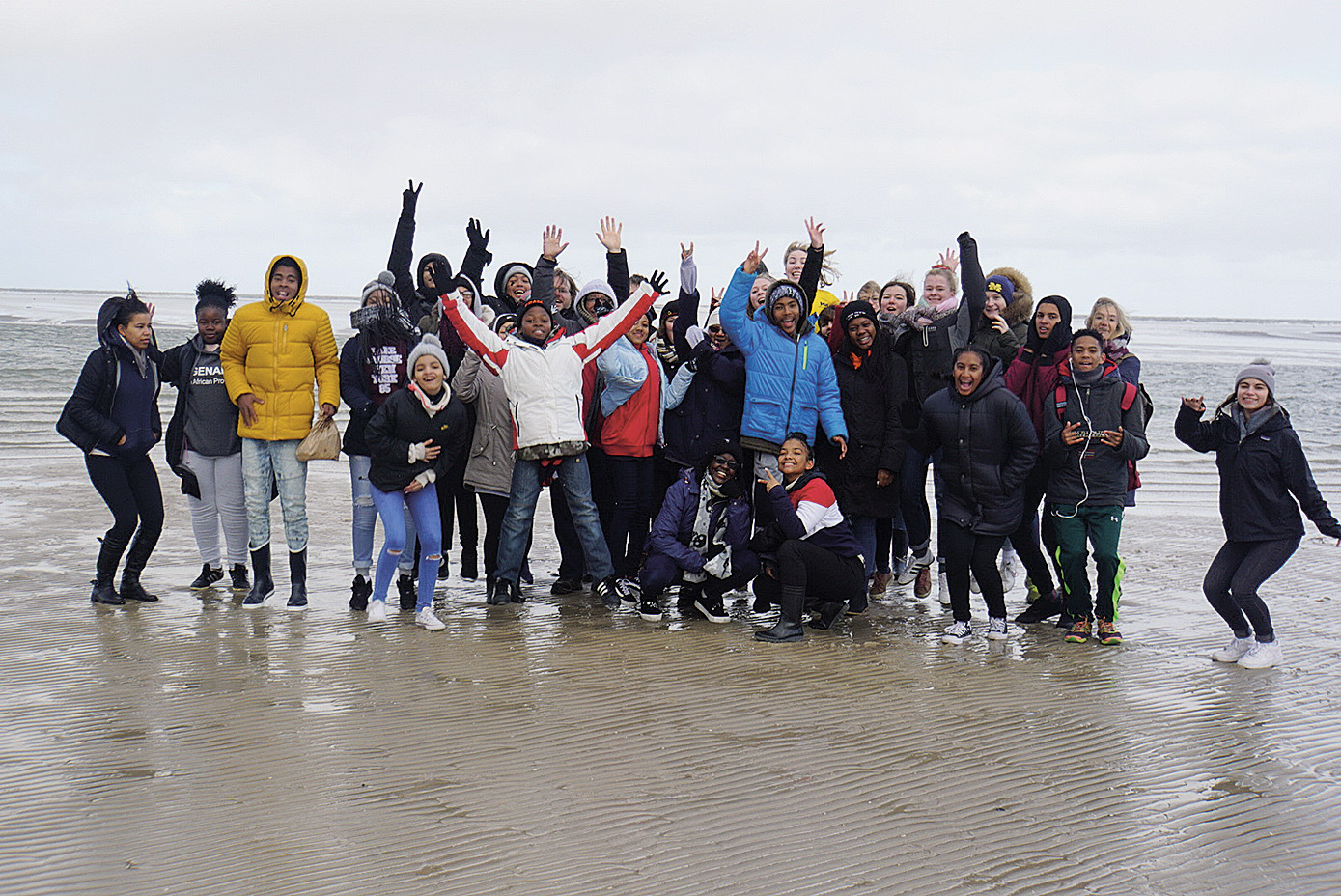
Students of the Willow Academy in Port Elizabeth, South Africa,
and the Helene-Lange-Schule in Oldenburg, Germany,
on an excursion to the Wadden Sea (Germany)
It can be very motivating for all participants if they develop or do something together with their partners. There are numerous ways to do this. For example, the results of a project can be presented by means of a newspaper, a blog or a book, or the participants can create a sculpture together. And they can also produce a joint play, a piece of music or even a film. While some activities can be planned and realised through digital exchanges, others definitely require a physical encounter. Although it is possible to create a virtual play, it is certainly more interesting for the participants if they can rehearse and/or perform it together.
It is also possible for the groups involved in the partnership to each develop their own product. For example, if both partners develop a school garden at the same time, the participants can exchange ideas about the process and report on what is happening in their respective garden. It is not always necessary to work together on the same project – the participants can also develop a strong bond and become very interested if they know that a group in another country is working on a similar project.
When working on a common product, it is important to make sure that the role of leader does not always fall to the same people. It is more beneficial and productive in the long term if different people from different countries can contribute their skills and lead the groups. This requires a certain degree of openness. Maybe there are people on both side who have experience in staging a play, for example, but the approaches are very different. This awareness helps the participants to recognise that there is not only one “right” approach, but that there are many different ones, and the question is whether these can be brought together in a single project or whether they should be applied to different projects. In addition, care should be taken both in the allocation of leadership tasks and in the distribution of tasks among the participants to ensure that roles are not assigned based on stereotypical beliefs. Sometimes stereotypes may turn out to be true, in which case this can be reflected in the distribution of tasks, provided that everyone is comfortable with it, but sometimes they prove false, or it can be exciting to consciously dismantle them.
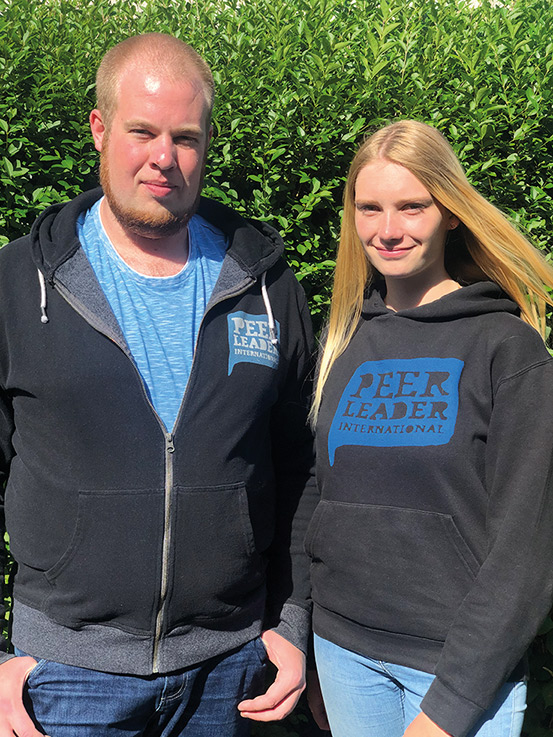
For us, global cooperation is about a change of perspective. Basically, everyone is thinking inside their own boxes. At least that was the case for us before we travelled out of our comfort zones into the world and developed projects together with young people from other countries. Through our experiences with new cultures, interesting people and countries that were initially foreign to us, we‘ve learned to think globally. More young people should have the opportunity to experience this, in order to facilitate multifaceted thinking and acting.
Katja Peper and Malte Frederichs
Peer Leader International, Germany
International education partnerships and projects can serve as an experimental space for (socio)political action. They can empower the participants to take up their own political positions while getting to know and trying out forms of action that allow them to make their voices heard. A low-threshold option is to present political statements to the outside world as part of public relations work, for example on a website, in a newspaper or in discussions with outsiders. A “product” developed together with the partners, such as a theatre or music piece, can have a political message, which may also develop in the course of the project. However, it is also possible to plan specific political actions from the outset and to carry them out together with all the partners – either within the framework of exchange visits or separately in the respective partner countries. Such actions could take the form of a flash mob, an organised demonstration, a campaign to collect signatures, (invisible) street theatre or similar activities.
The advantage of joint political action is that an international group usually receives a great deal of attention. Such an “international presence” makes it easier to reach not only the general public, but also politicians. It is important, however, not to instrumentalise the international guests for political actions that are not shared by the other side. In this context, there should be room for controversial political discussions without indoctrinating the participants.
When carrying out political actions, it is also essential to be familiar with the legal regulations governing different forms of protest and the local conditions so as not to put the participants at risk. The legal provisions governing public expressions of opinion and political action differ from country to country. For this reason, you should discuss with your partners what types of activities can be carried out in the respective country in a manner that is both legally and socially safe. If participants from another country get into trouble with the police or the law and their behaviour is considered a criminal offence, this can mean, among other things, that they will have difficulties applying for a visa in the future.
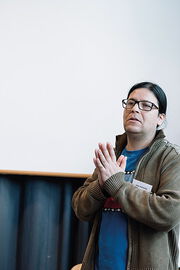
The possibility of building bridges between institutions in various territories around the globe to achieve common objectives that impact people‘s lives and environments has been an extraordinary experience. The political pressure exercised by a letter signed by activists from all over the world or the intentionality of a prayer can make a difference for the re-education of humanity.
Jorge Alejandro Huichalaf Díaz
Teacher at the Koyam Primary School and President of the Mapuche Credit Union “Küme mogen”, Wallmapu (territory of the Mapuche in Chile and Argentina)